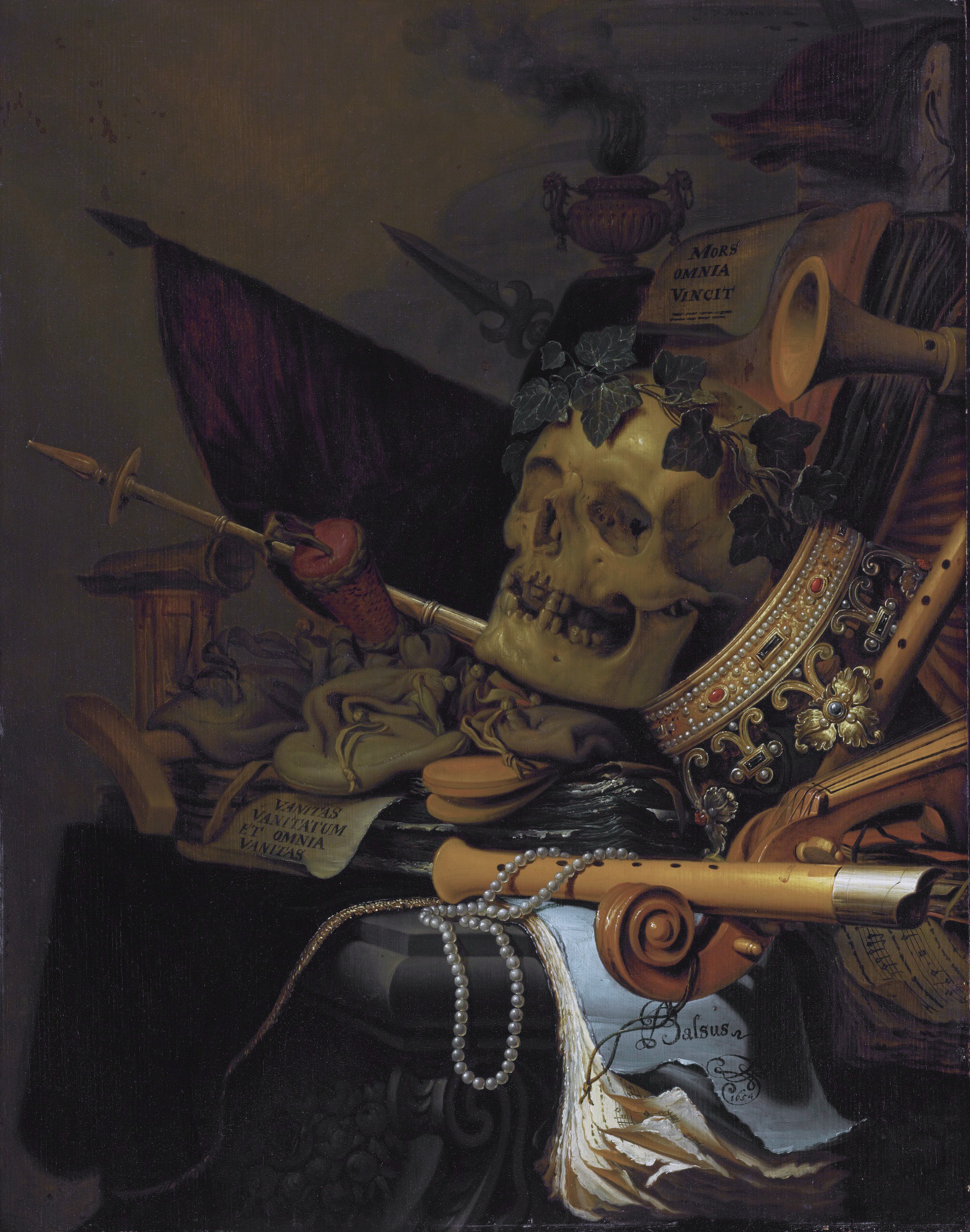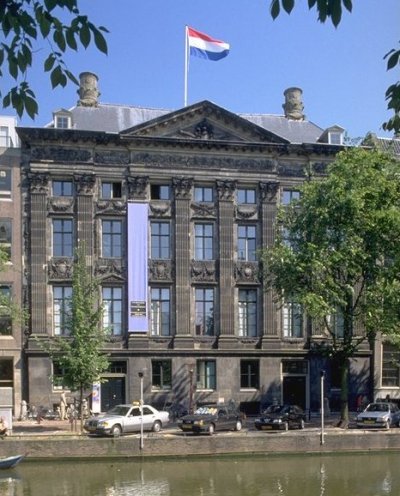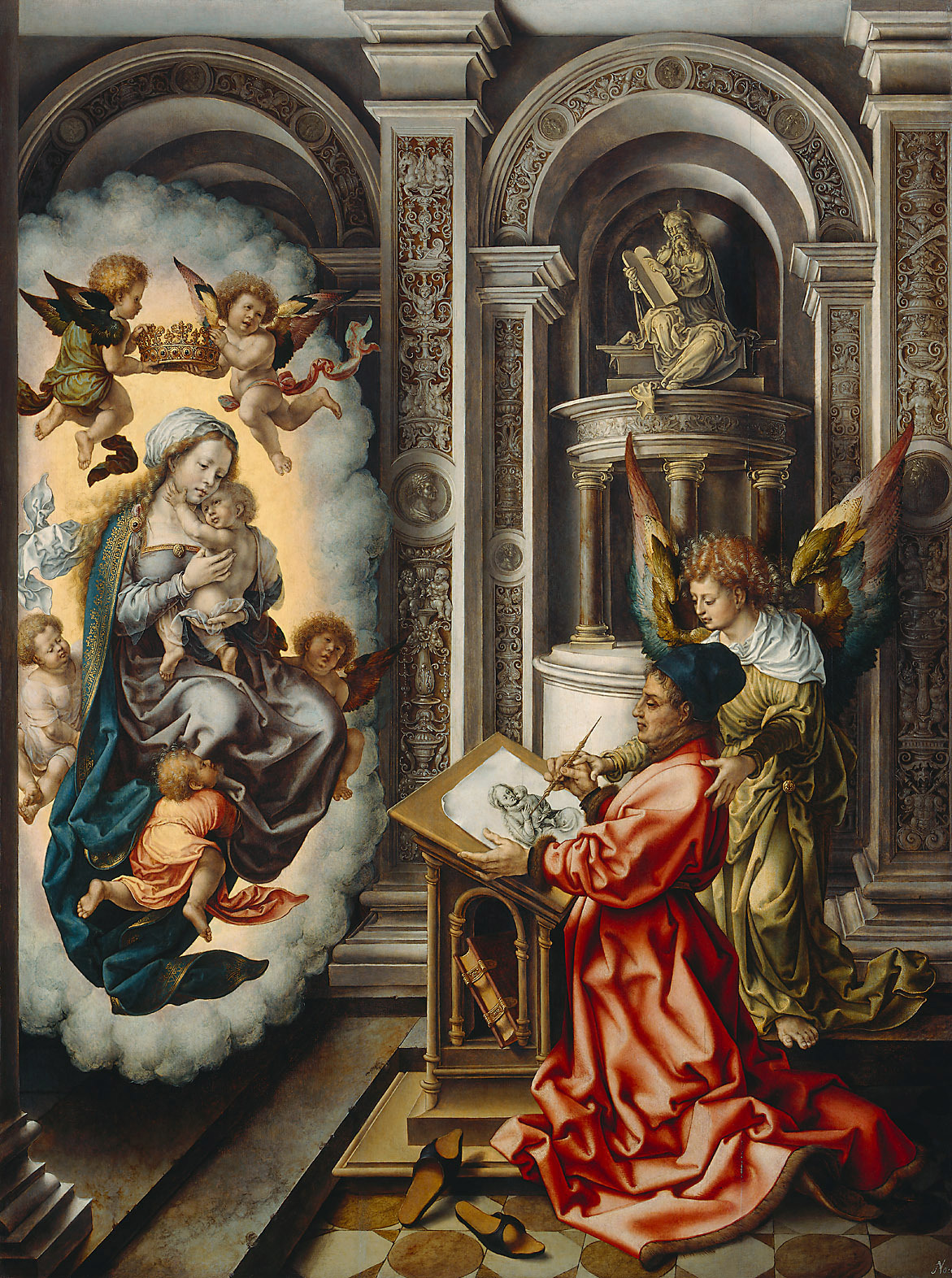|
Jan Vermeulen
Johannes van der Molen or Johannes Jan Vermeulen was a still-life painter during the Dutch Golden Age. He was active in Haarlem from 1638 to 1674. His specialty was the Vanitas, a style of painting meant to symbolize the transience of life. Many of them feature books. Life and work Nothing is known about his artistic training. He is documented for the first time in 1638 in Haarlem. In 1651, he is on an archival list of the Guild of Saint Luke, as a member and a citizen of Haarlem, under the name Johannes van der Meulen. In 1674, he is recorded in church documents as having been married for the second time, after which no further mention of him has yet been discovered. Very few works by this artist are known with any certainty. In addition to books, they include scientific objects and musical instruments, with a limited color range. Paintings with the monogram IVM, dating from 1661 may be his, although some sources say those works belong to an Isaac Vermeulen. Some of his wor ... [...More Info...] [...Related Items...] OR: [Wikipedia] [Google] [Baidu] |
Jan Vermeulen 001
Jan, JaN or JAN may refer to: Acronyms * Jackson, Mississippi (Amtrak station), US, Amtrak station code JAN * Jackson-Evers International Airport, Mississippi, US, IATA code * Jabhat al-Nusra (JaN), a Syrian militant group * Japanese Article Number, a barcode standard compatible with EAN * Japanese Accepted Name, a Japanese nonproprietary drug name * Job Accommodation Network, US, for people with disabilities * ''Joint Army-Navy'', US standards for electronic color codes, etc. * ''Journal of Advanced Nursing'' Personal name * Jan (name), male variant of ''John'', female shortened form of ''Janet'' and ''Janice'' * Jan (Persian name), Persian word meaning 'life', 'soul', 'dear'; also used as a name * Ran (surname), romanized from Mandarin as Jan in Wade–Giles * Ján, Slovak name Other uses * January, as an abbreviation for the first month of the year in the Gregorian calendar * Jan (cards), a term in some card games when a player loses without taking any tricks or scoring a m ... [...More Info...] [...Related Items...] OR: [Wikipedia] [Google] [Baidu] |
Still-life
A still life (: still lifes) is a work of art depicting mostly inanimate subject matter, typically commonplace objects which are either natural (food, flowers, dead animals, plants, rocks, shells, etc.) or human-made (drinking glasses, books, vases, jewelry, coins, pipes, etc.). With origins in the Middle Ages and Ancient Greco-Roman art, still-life painting emerged as a distinct genre and professional specialization in Western painting by the late 16th century, and has remained significant since then. One advantage of the still-life artform is that it allows an artist much freedom to experiment with the arrangement of elements within a composition of a painting. Still life, as a particular genre, began with Netherlandish painting of the 16th and 17th centuries, and the English term ''still life'' derives from the Dutch word ''stilleven''. Early still-life paintings, particularly before 1700, often contained religious and allegorical symbolism relating to the objects depict ... [...More Info...] [...Related Items...] OR: [Wikipedia] [Google] [Baidu] |
Dutch Golden Age
The Dutch Golden Age ( ) was a period in the history of the Netherlands which roughly lasted from 1588, when the Dutch Republic was established, to 1672, when the '' Rampjaar'' occurred. During this period, Dutch trade, scientific developments, art and overseas colonisation was among the most prominent in Europe. The first half of the period spanned from the beginning of the Eighty Years' War until its conclusion in 1648, with the second half lasting until the outbreak of the Franco-Dutch War. During the period, Dutch colonialists, many of them affiliated with the East India Company and West India Company, established trading posts and colonies in the Americas, Southern Africa and Asia, protected by the powerful Dutch States Navy. The Dutch also dominated the triangular trade and Atlantic slave trade during this period. Dutch culture flourished during this period as well. However, by the end of the 17th century, conflicts with neighbouring powers as well as declining eco ... [...More Info...] [...Related Items...] OR: [Wikipedia] [Google] [Baidu] |
Haarlem
Haarlem (; predecessor of ''Harlem'' in English language, English) is a List of cities in the Netherlands by province, city and Municipalities of the Netherlands, municipality in the Netherlands. It is the capital of the Provinces of the Netherlands, province of North Holland. Haarlem is situated at the northern edge of the Randstad, one of the Largest European cities and metropolitan areas, more populated metropolitan areas in Europe; it is also part of the Amsterdam metropolitan area. Haarlem had a population of in . Haarlem was granted city status or in 1245, although the first city walls were not built until 1270. The modern city encompasses the former municipality of Schoten, Netherlands, Schoten as well as parts that previously belonged to Bloemendaal and Heemstede. Apart from the city, the municipality of Haarlem also includes the western part of the village of Spaarndam. Newer sections of Spaarndam lie within the neighbouring municipality of Haarlemmermeer. Geography ... [...More Info...] [...Related Items...] OR: [Wikipedia] [Google] [Baidu] |
Vanitas
''Vanitas'' is a genre of symbolizing the temporality, transience of life, the futility of pleasure, and the certainty of death, and thus the vanity of ambition and all worldly desires. The paintings involved still life imagery of transitory items. The genre began in the 16th century and continued into the 17th century. Vanitas art is a type of allegorical art representing a higher ideal. It was a sub-genre of painting heavily employed by Dutch painters during the Baroque period (c.1585–1730). Spanish painters working at the end of the Spanish Golden Age also created vanitas paintings. Etymology The word ''vanitas'' comes from Latin and means vanity. In this context, vanity means pointlessness, or futility, not to be confused with the other definition of vanity. Vanity is referenced in the Hebrew Bible in Ecclesiastes 12, Ecclesiastes 12:8, "Vanity of Vanities, saith the preacher, all is vanity". In some versions vanity is translated as "meaningless" to avoid the confusion ... [...More Info...] [...Related Items...] OR: [Wikipedia] [Google] [Baidu] |
Guild Of Saint Luke
The Guild of Saint Luke was the most common name for a city guild for painters and other artists in early modern Europe, especially in the Low Countries. They were named in honor of the Evangelist Luke, the patron saint of artists, who was identified by John of Damascus as having painted the Virgin's portrait. One of the most famous such organizations was founded in Antwerp. It continued to function until 1795, although by then it had lost its monopoly and therefore most of its power. In most cities, including Antwerp, the local government had given the Guild the power to regulate defined types of trade within the city. Guild membership, as a master, was therefore required for an artist to take on apprentices or to sell paintings to the public. Similar rules existed in Delft, where only members could sell paintings in the city or have a shop. The early guilds in Antwerp and Bruges, setting a model that would be followed in other cities, even had their own showroom or market s ... [...More Info...] [...Related Items...] OR: [Wikipedia] [Google] [Baidu] |
Monogram
A monogram is a motif (visual arts), motif made by overlapping or combining two or more letters or other graphemes to form one symbol. Monograms are often made by combining the initials of an individual or a company, used as recognizable symbols or logos. A series of uncombined initials is properly referred to as a cypher (e.g. a royal cypher) and is not a monogram. Many of today's monograms are embroidered on items for the home like towels, bedding, robes etc. History Monograms first appeared on coins, as early as 350 BC. The earliest known examples are of the names of Greek cities which issued the coins, often the first two letters of the city's name. For example, the monogram of Achaea (ancient region), Achaea consisted of the letters alpha (Α) and chi (letter), chi (Χ) joined together. Monograms have been used as signatures by artists and Artisan, craft workers on paintings, sculptures and pieces of furniture, especially when guilds enforced measures against unauthor ... [...More Info...] [...Related Items...] OR: [Wikipedia] [Google] [Baidu] |
Mauritshuis
The Mauritshuis (, ; ) is an art museum in The Hague, Netherlands. The museum houses the Royal Cabinet of Paintings which consists of 854 objects, mostly Dutch Golden Age paintings. The collection contains works by Johannes Vermeer, Rembrandt van Rijn, Jan Steen, Paulus Potter, Frans Hals, Jacob van Ruisdael, Hans Holbein the Younger, and others. Originally, the 17th-century building was the residence of Count John Maurice of Nassau. The building is now the property of the government of the Netherlands and is listed in the top 100 Dutch heritage sites. History In 1631, John Maurice, Prince of Nassau-Siegen, a cousin of Stadtholder Frederick Henry, Prince of Orange, Frederick Henry, bought a plot bordering the Binnenhof and the adjacent Hofvijver pond in The Hague, at that time the political centre of the Dutch Republic. Between 1636 and 1641, the Mauritshuis was built on this piece of land, during John Maurice's governorship of Dutch Brazil. It was built in the Dutch Baroque a ... [...More Info...] [...Related Items...] OR: [Wikipedia] [Google] [Baidu] |
Schloss Johannisburg
Schloss Johannisburg is a schloss in the town of Aschaffenburg, in Franconia, in the state of Bavaria, Germany. It was erected between 1605 and 1614 by the architect for Johann Schweikhard von Kronberg, Prince Bishop of Mainz. Until German mediatization, 1803, it was the second residence of the Electorate of Mainz, Archbishop and Prince Elector of Mainz. It is constructed of red sandstone, the typical building material of the Spessart, the hills near Aschaffenburg. Location ''Schloss Johannisburg'' is located in the city of Aschaffenburg, in the district of Lower Franconia of the state of Bavaria, Germany. It is situated in the center of the city, overlooking the river Main (river), Main. History The palace was erected between 1605 and 1614 by the architect for Johann Schweikhard von Kronberg, Archbishop of Mainz. The considerable expense came from the taxes of his fief: Eichsfeld, Erfurt and the ''Mainzer Oberstift'' (the part of the Electorate administered from Aschaffen ... [...More Info...] [...Related Items...] OR: [Wikipedia] [Google] [Baidu] |
Musée Des Beaux-arts De Nantes
The Fine Arts Museum of Nantes (French: Musée d'Arts de Nantes), along with 14 other provincial museums, was created, by consular decree on 14 Fructidor in year IX (31 August 1801). Today the museum is one of the largest museums in the region. The facades, roof and stairs in the building that houses the art collections have been registered as historical monuments since 29 October 1975. On 18 December 2011, the museum closed its doors for what was initially expected to be two years at most, to carry out extension expansion work. Due to problems associate with the discovery of ground water in the foundations, which required almost four years of additional work, the reopening of the entire building (renamed the "Art Museum of Nantes") was postponed until 23 June 2017. Overview Founded under the Consulate by Napoléon Bonaparte, the Fine Arts Museum of Nantes receives work purchased by state and the central museum deposits (the Louvre). It takes from the 19th century, where it w ... [...More Info...] [...Related Items...] OR: [Wikipedia] [Google] [Baidu] |
Sotheby's
Sotheby's ( ) is a British-founded multinational corporation with headquarters in New York City. It is one of the world's largest brokers of fine art, fine and decorative art, jewellery, and collectibles. It has 80 locations in 40 countries, and maintains a significant presence in the UK. Sotheby's was established on 11 March 1744 in London by Samuel Baker, a bookseller. In 1767 the firm became Baker & Leigh, after George Leigh became a partner, and was renamed to Leigh and Sotheby in 1778 after Baker's death when his nephew, John Sotheby, inherited Leigh's share. Other former names include: Leigh, Sotheby and Wilkinson; Sotheby, Wilkinson and Hodge (1864–1924); Sotheby and Company (1924–83); Mssrs Sotheby; Sotheby & Wilkinson; Sotheby Mak van Waay; and Sotheby's & Co. The American holding company was initially incorporated in August 1983 in Michigan as Sotheby's Holdings, Inc. In June 2006, it was reincorporated in the State of Delaware and was renamed Sotheby's. In June ... [...More Info...] [...Related Items...] OR: [Wikipedia] [Google] [Baidu] |








